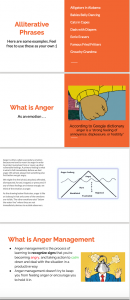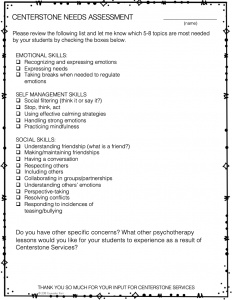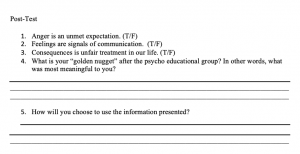The special project I will be implementing is “Social-Emotional Learning (SEL) at Goal Academy.” In consideration to Covid-19 restrictions, I will be utilizing 4-8 group therapy sessions with 3-8 students weekly.
- Social Emotional Learning
- Goal Academy
- Centerstone
- Three months
- 3-12 students weekly
Social Issue
The social issue being addressed is managing emotions, forming positive relationships, and showing empathy for others among the students of Goal Academy. These individuals face many challenges common to students, such as bullying, mental health issues, learning to manage negative emotions and stress, and developing positive relationships with peers. I have recently sent a needs assessment to the school counselor for feedback from teachers and staff. Based off the responses, the psycho-educational groups will be tailored accordingly.
Interventions
The mission of SEL programs is to enhance academic outcomes and improve behaviors of the students participating in SEL programs by increasing ability to manage stress and depression, and better attitudes about themselves, others and school (“CASEL Guide,” 2015). The goal is to implement psycho-educational groups, mindfulness and other positive coping skills, resiliency building, elements of cognitive behavioral therapy, and motivational interviewing. Literature has shown that the positive youth development approach empowers students to use their strengths to develop universal social and emotional learning (SEL) to enhance their long-term wellbeing (Paricio et al. 2020).
The theoretical framework for the psychoeducational groups includes person-in environment, cognitive model, and trauma informed care in order to help assist students. The person in environment theory states that a person is heavily influenced by their environment; and their problems and issues can be largely understood by environmental influences (Tyler, 2021). The cognitive model theory asserts that people’s perceptions of situations influence their emotional and behavioral reaction (Asegur, 2020). Trauma informed care recognizes the presence of trauma symptoms and acknowledges the role trauma may play in an individual’s life (Vines, 2020). These frameworks help to understand the reasons some adolescents have difficulty with their social and emotional functioning.
During adolescence, there is an imbalance that exists between cognitive and motivational nerve connections that produce a certain vulnerability and increase impulsiveness and risk-taking. Therefore, social emotional learning strategies support cognitive processing which encourage healthy brain development for adolescents. Peer-reviewed empirical data affirm that empathy and emotional skills are strongly related, and they make it possible to acquire and keep friendships and manage social problems more effectively (Paricio et al. 2020). Social, emotional learning strategies encourage students to have more positive relationships with peers and adults and have more positive emotional adjustment and mental health (Crooks et al, 2015). In addition, social emotional learning personalizes the education process and engages students in instruction that is relevant to their development (Durlak et al. 2017). Social emotional learning offers opportunities for deeper learning and connection to the world beyond school.
Results
Completed 8 week worth of social emotional learning lessons in Goal Academy. Due to the nature of Covid-19 groups were done per classroom. There was a total of 4 classrooms. Those who participated only received 3 lessons of the 8-week curriculum that I created. There were roughly 12 students in attendance per classroom. There are no recognitions or rewards for this project. About 10 students are receiving individual therapy with Centerstone therapist during the special project.
Conclusions
I attempted to collaborate with the school counselor and provided her with a need’s assessment to be administered to the school staff. In the needs assessment I was looking to gather data on which social emotional interventions would be most relevant for the students from the staff perspective. An unexpected outcome was that it was determined that I would be assisting in anger management psycho educational groups by the school counselor and dean of students. I was not able to follow through with an official needs assessment but rather spoke to the decision makers of the program I was helping to enhance.
Limitations
Current limitation included time to propose and begin implementing the project. I was the only individual implementing the project. In addition, I was the only individual with a social work background with the support of a licensed professional counselor. It was difficult attempting to explain my distinct role a social worker in the school setting providing behavioral health services. The Centerstone professional who was at Goal Academy ended up leaving two months after I began facilitating groups. During the change in Centerstone staff students had to get acclimated with a new clinician in the middle of the psychoeducational groups. Covid-19 guidelines created obstacles for the Trek program due to social distancing and not being able to move from classroom to classroom. I think that attempting to do online groups for a consistent group could have been one way to enhance the efficacy of the psychoeducational group.
Nine Social Work Competencies
Competency 1 Ethics and professionalism
- I will use technology ethically in order to create, implement, and evaluate my special project.
Competency 2: Diversity
- I will be providing group therapy services to a population that could not otherwise be able to receive services due to socioeconomic status.
Competency 3: Human rights and justice
- This project will train staff on human rights through the social emotional intervention strategies and research. It will also bring justice to those who are facing discrimination by continued awareness of diversity.
Competency 4: Research
- I ensured that all participants completed a pre and post survey related to social emotional learning with an emphasis on anger management.
Competency 5: Policy practice
- I established group rules which included respect and taking turns when speaking.
Competency 6: Engagement
- I engaged with each group member while presenting the social emotional learning lesson. In addition to Goal Academy, I engaged with Centerstone to provide outpatient services.
Competency 7: Assessment
- I made an attempt to use a needs assessment in order to proceed with gathering social emotional learning skills the teachers thought their students lacked in. However, this needs assessment was overridden by the school counselor due to Covid-19 and expressing need in the enhancement of the anger management psycho educational group.
Competency 8: Intervention
- I created an 8-week anger management SEL curriculum to teach strategies for students at Goal Academy.
Competency 9: Evaluation
- Upon the completion of the psychoeducational group’s students were given a posttest to evaluate which lessons were of value and if they retained any of the material presented.
Sources
Asegur, E. (2020). Cognitive model: Theory OF Psychopathology: Beck Institute. Retrieve from https://beckinstitute.org/cognitive-model/
Durlak, J. A., Domitrovich, C. E., Weissberg, R. P., Gullotta, T. P., & Comer, J. P. (2017). Social and Emotional Learning Past, Present, and Future. In Handbook of social and emotional learning: Research and practice (pp. 3-16). New York, NY: Guilford Press.
CASEL Guide. (2015). Retrieved from http://secondaryguide.casel.org/
Crooks, C. V., Scott, K. L., Broll, R., Zwarych, S., Hughes, R., & Wolfe, D. A. (2015). Does an evidence-based healthy relationships program for 9th graders show similar effects for 7th and 8th graders? Results from 57 schools randomized to intervention. Health Education Research, 30(3), 513–519. https://doi-org.ezproxy.southern.edu/her/cyv014
Paricio, D., Rodrigo, M. F., Viguer, P., & Herrera, M. (2020). Positive Adolescent Development: Effects of a Psychosocial Intervention Program in a Rural Setting. International Journal of Environmental Research and Public Health, 17(18). https://doi-org.ezproxy.southern.edu/10.3390/ijerph17186784
Tyler, S. (2021). The person in environment. Retrieved from https://uark.pressbooks.pub/hbse1/part/main-body/
Vines, L. (2020). What is Trauma-Informed Care? Retrieved from http://socialwork.buffalo.edu/social-research/institutes-centers/institute-on-trauma-and-trauma-informed-care/what-is-trauma-informed-care.html




